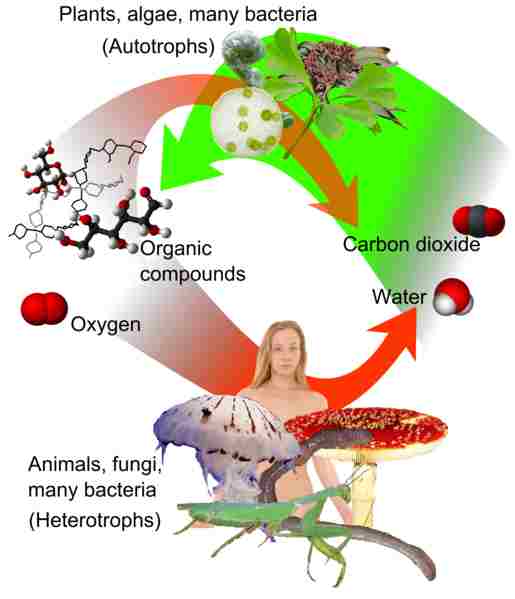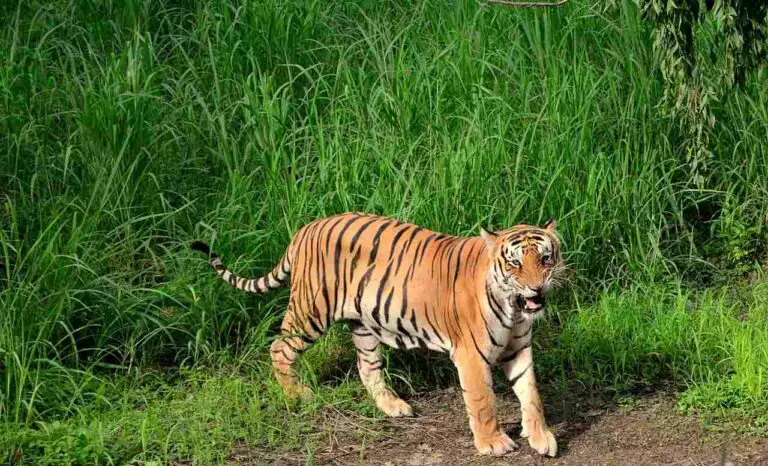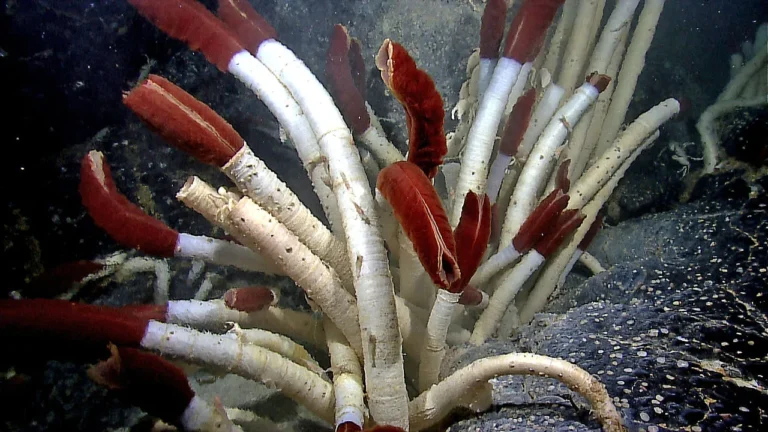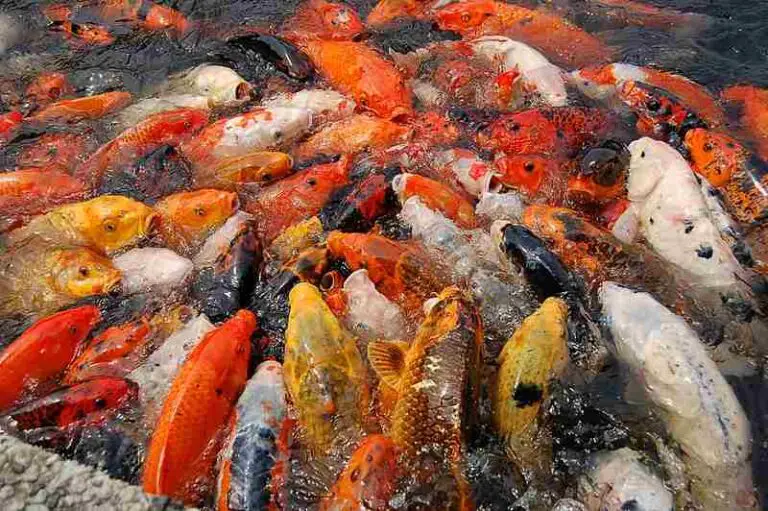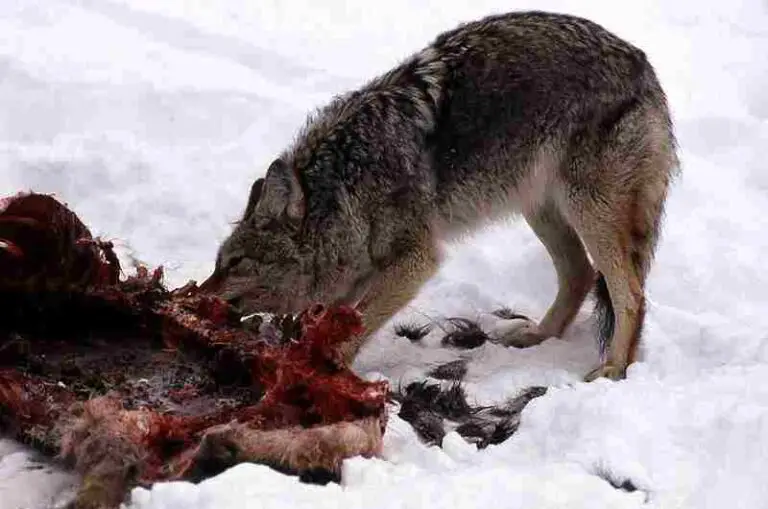What Eats a Parrotfish? 7+ Parrotfish Predators Discussed
Predators of the parrotfish are mainly moral eel and blacktip reef shark, along with others like tiger shark, grey reef shark, barracuda, groupers, snappers, and humans.
What Animals Eat Parrotfish?
1). Moral Eel
The moral eel is one of the animals that eat parrotfish. This fascinating creature can be found in various tropical and subtropical oceans around the world. With its sleek and elongated body, the moral eel is well-adapted for hunting and capturing its prey.
When it comes to parrotfish, the moral eel has developed unique strategies to capture and consume them. Using its powerful jaws and sharp teeth, the moral eel swiftly strikes at unsuspecting parrotfish, immobilizing them with its strong bite. It then proceeds to swallow the parrotfish whole, taking advantage of its flexible body to accommodate its prey.
The moral eel is not solely dependent on parrotfish for its diet. It also preys on other small fish, crustaceans, and even cephalopods. This diverse diet ensures that the moral eel can adapt to different environments and find sustenance wherever it resides.
In terms of behavior, the moral eel is known for its solitary nature. It prefers to hunt alone, using its excellent camouflage skills to blend into its surroundings and surprise its prey. This stealthy approach allows the moral eel to maximize its chances of a successful hunt.
It’s important to note that the moral eel plays a crucial role in maintaining the balance of the marine ecosystem. By preying on parrotfish, it helps control their population and prevent overgrazing on coral reefs. This, in turn, contributes to the overall health and resilience of coral reef ecosystems.
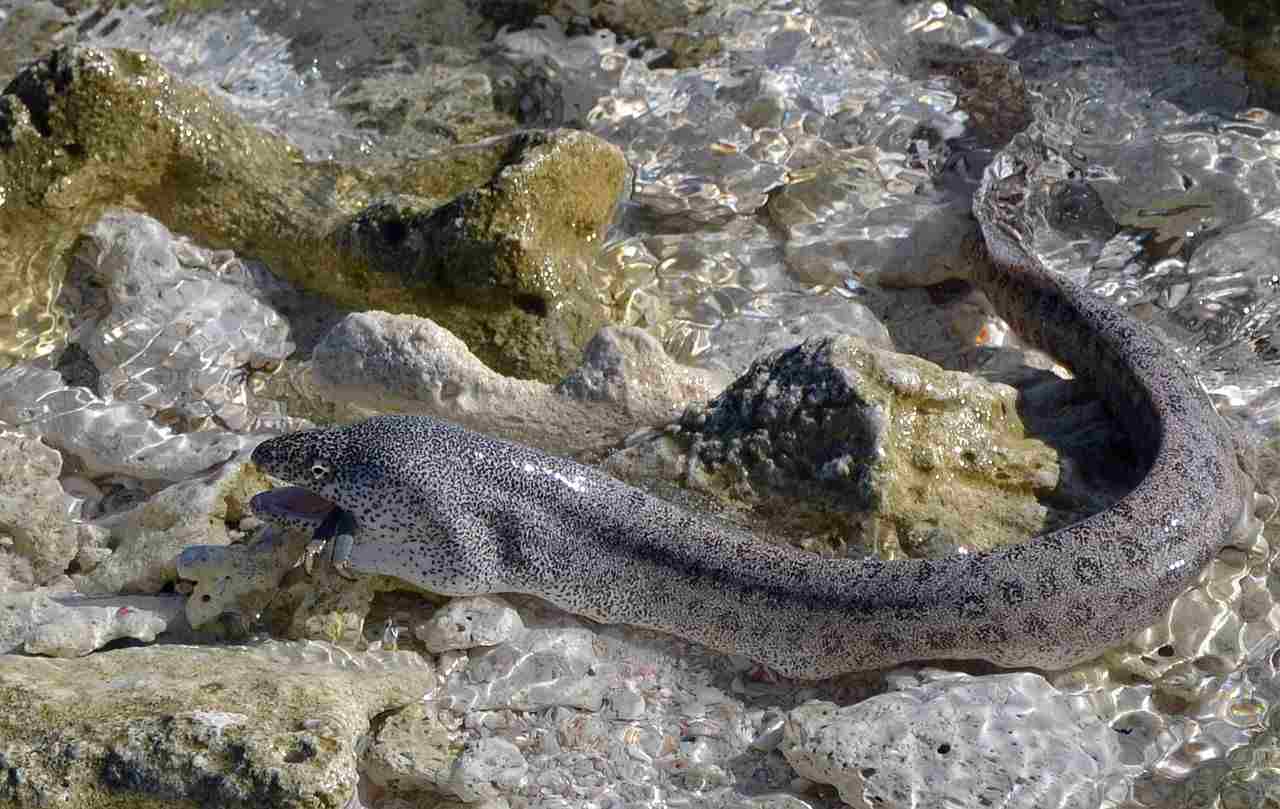
2). Blacktip Reef Shark
The Blacktip Reef Shark is another predator that preys on parrotfish in their natural habitat. These sharks can be found in the warm coastal waters of the Indo-Pacific region, including the Red Sea, Indian Ocean, and the Pacific Ocean.
With their sleek bodies and distinctive black-tipped fins, Blacktip Reef Sharks are well-adapted for hunting in coral reef ecosystems. They are known for their agility and speed, making them efficient hunters.
When it comes to capturing and consuming parrotfish, Blacktip Reef Sharks use their sharp teeth and powerful jaws to their advantage. They rely on their keen senses, particularly their acute sense of smell, to detect the presence of parrotfish in the water. Once they locate their prey, they swiftly swim towards them, using their speed to surprise and capture the parrotfish.
Blacktip Reef Sharks are opportunistic predators and will also prey on other small fish, crustaceans, and even cephalopods. Their diverse diet allows them to adapt to different food sources and environments.
These sharks play a crucial role in maintaining the balance of the coral reef ecosystem. By preying on parrotfish, they help regulate their population and prevent overgrazing on coral reefs. This ensures the health and resilience of the coral reef ecosystem as a whole.
It’s important to note that Blacktip Reef Sharks are not a threat to humans unless provoked. They are generally shy and tend to avoid human interaction. However, it is always advisable to exercise caution and respect their natural habitat when encountering them in the wild.
3). Tiger Shark
Tiger Sharks are another formidable predator that preys on parrotfish in their natural habitat. These sharks can be found in warm tropical waters around the world, including the Caribbean Sea, the Gulf of Mexico, and the western Pacific Ocean.
With their powerful jaws and serrated teeth, Tiger Sharks are well-equipped to capture and consume parrotfish. They are known for their voracious appetite and will feed on a wide variety of prey, including fish, turtles, seals, and even dolphins.
When it comes to hunting parrotfish, Tiger Sharks use their keen senses, particularly their excellent sense of smell, to detect the presence of their prey. Once they locate a school of parrotfish, they employ their stealth and agility to swiftly swim towards them. With a burst of speed, they launch a surprise attack, using their sharp teeth to capture and consume the parrotfish.
Tiger Sharks are opportunistic predators and will also prey on other marine creatures, such as rays, crustaceans, and even seabirds. Their diverse diet allows them to adapt to different food sources and environments.
By preying on parrotfish, Tiger Sharks play a crucial role in maintaining the balance of the marine ecosystem. They help control the population of parrotfish, preventing overgrazing on coral reefs and ensuring the overall health and resilience of the ecosystem.
4). Grey Reef Shark
The Grey Reef Shark is another predator that preys on parrotfish in their natural habitat. These sharks can be found in the Indo-Pacific region, particularly around coral reefs and lagoons.
With their sleek bodies and powerful jaws, Grey Reef Sharks are well-adapted to capturing and consuming parrotfish. They are known for their speed and agility, allowing them to swiftly swim towards their prey. Once they spot a school of parrotfish, they use their sharp teeth to capture and consume them.
Grey Reef Sharks are opportunistic predators and will also prey on other small fish, crustaceans, and even octopuses. Their diverse diet enables them to adapt to different food sources and environments, ensuring their survival in the marine ecosystem.
These sharks play a crucial role in maintaining the balance of the coral reef ecosystem. By preying on parrotfish, they help control their population and prevent overgrazing on coral reefs. This allows the reefs to thrive and provides a habitat for a wide variety of marine species.
It is important to note that Grey Reef Sharks are not a threat to humans unless provoked. They are generally shy and will avoid human interaction. However, it is always advisable to exercise caution when swimming in areas where these sharks are known to inhabit.
5). Barracuda
Barracudas are one of the animals that prey on parrotfish in their natural habitat. These predatory fish can be found in tropical and subtropical waters around the world, including coral reefs and coastal areas.
Known for their sleek and elongated bodies, barracudas are swift swimmers that rely on their speed and agility to capture and consume their prey. When hunting parrotfish, barracudas use their sharp teeth and powerful jaws to seize their target. They are opportunistic predators and will also feed on other small fish and crustaceans.
Barracudas are known for their voracious appetite and can consume large quantities of parrotfish in a short period of time. Their hunting behavior plays an important role in regulating the population of parrotfish and maintaining the health of coral reefs.
It is worth noting that barracudas are not typically a threat to humans unless provoked or mistaken for food. However, caution should always be exercised when swimming in areas where barracudas are present, as they can be territorial and may exhibit aggressive behavior if they feel threatened.
6). Groupers
Groupers are another animal that preys on parrotfish in their natural habitat. These large predatory fish can be found in various marine environments, including coral reefs and rocky areas. With their powerful jaws and sharp teeth, groupers are well-equipped to capture and consume parrotfish.
Groupers are ambush predators, patiently waiting for their prey to come within striking distance. Once a parrotfish is within range, the grouper will swiftly swim towards it and use its strong jaws to capture the unsuspecting fish. Groupers have a voracious appetite and can consume parrotfish whole, thanks to their expandable stomachs.
In addition to parrotfish, groupers also prey on a variety of other small fish and crustaceans. They are opportunistic feeders and will take advantage of any available food source. This predatory behavior helps to maintain the balance of the marine ecosystem by controlling the population of parrotfish and other prey species.
Groupers are known for their size and strength, with some species reaching lengths of up to several feet and weighing over 100 pounds. Their large size and impressive hunting abilities make them formidable predators in the underwater world. However, they are not typically a threat to humans unless provoked or cornered.
It is important to note that some grouper species, such as the Nassau grouper, are considered endangered due to overfishing and habitat destruction. Conservation efforts are underway to protect these magnificent fish and ensure their survival for future generations. By understanding the role groupers play in the ecosystem, we can work towards preserving their habitats and maintaining the delicate balance of marine life.
7). Snappers
Snappers are another predator of parrotfish in their natural habitat. These carnivorous fish can be found in various marine environments, including coral reefs and rocky areas. With their sharp teeth and powerful jaws, snappers are well-equipped to capture and consume parrotfish.
Snappers are opportunistic feeders and will take advantage of any available food source, including parrotfish. They are known for their quick and agile swimming abilities, allowing them to swiftly chase down their prey. Once a parrotfish is within range, the snapper will use its sharp teeth to capture and consume the unsuspecting fish.
In addition to parrotfish, snappers also prey on a variety of other small fish and crustaceans. They play an important role in maintaining the balance of the marine ecosystem by controlling the population of parrotfish and other prey species.
Snappers come in a variety of species, each with its own unique characteristics and hunting strategies. Some species, like the mutton snapper, are known for their large size and impressive strength. Others, like the yellowtail snapper, are known for their vibrant colors and ability to blend in with their surroundings.
While snappers are predators of parrotfish, they are not typically a threat to humans. However, it is important to respect their natural habitat and avoid any actions that may disrupt the delicate balance of the marine ecosystem.
8). Humans
Humans are one of the main predators of parrotfish. As the dominant species on Earth, humans have a significant impact on the population of parrotfish. In many coastal communities, parrotfish are targeted for their meat and are caught through various fishing methods.
In some regions, parrotfish are considered a delicacy and are highly sought after for their unique taste and texture. They are often caught using fishing nets, spears, or traps. Once caught, parrotfish are typically cleaned, cooked, and served as a meal.
The consumption of parrotfish by humans has raised concerns among conservationists and marine biologists. Parrotfish play a crucial role in maintaining the health of coral reefs by grazing on algae that can smother coral. By reducing the population of parrotfish, humans indirectly contribute to the degradation of coral reefs.
Furthermore, the destruction of coral reefs due to human activities such as pollution and climate change also affects the habitat and food sources of parrotfish. This further threatens their population and disrupts the delicate balance of the marine ecosystem.
Efforts are being made to raise awareness about the importance of preserving parrotfish populations and their habitats. Sustainable fishing practices, such as implementing size limits and protected areas, can help ensure the long-term survival of parrotfish and the health of coral reefs.
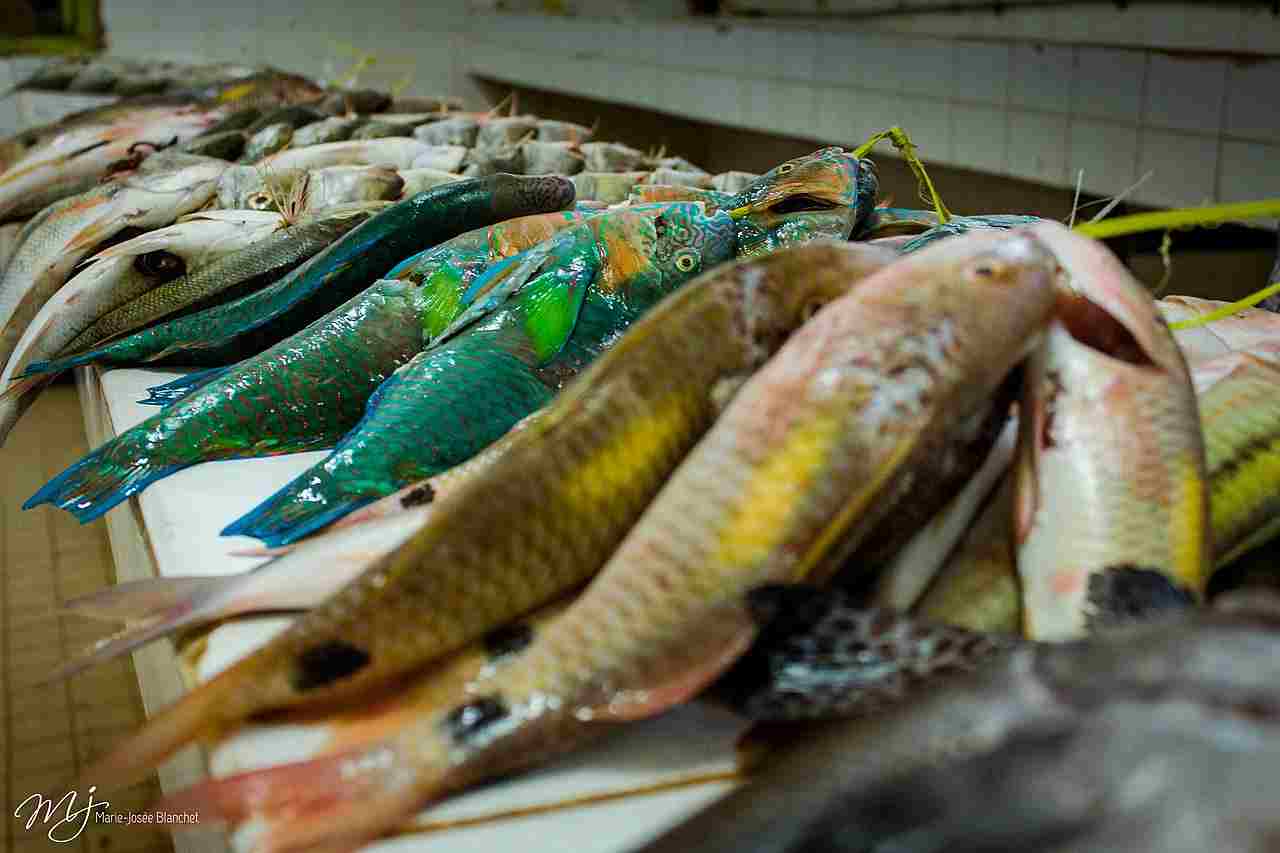
How Parrotfish Protect Themselves from Predators
Parrotfish have developed several mechanisms to protect themselves from predators in their marine habitats. These adaptations help them evade detection and increase their chances of survival.
One of the primary ways parrotfish protect themselves is through their scales. These scales act as a physical barrier, providing a layer of protection against potential threats. The scales are tough and can withstand the sharp teeth of predators such as sharks and barracudas. This defense mechanism allows parrotfish to minimize the risk of injury and escape from potential predators.
In addition to their scales, parrotfish have developed unique behaviors to avoid predation. During the day, parrotfish can often be seen grazing on algae and coral reefs. However, at night, they employ different strategies to protect themselves. Some species of parrotfish burrow themselves in the sand, creating a safe hiding spot where they can rest and avoid predators. Others seek refuge in crevices and coral formations, using their small size and agility to their advantage.
Another fascinating adaptation of parrotfish is their ability to secrete a clear mucous cocoon around themselves at night. This mucous cocoon serves multiple purposes. Firstly, it helps mask the scent of the parrotfish, making it more difficult for predators like sharks and moray eels to detect them. Secondly, the mucous cocoon provides an additional layer of protection, acting as a barrier against potential threats. This adaptation allows parrotfish to sleep peacefully without the constant fear of predation.
The glands of the parrotfish play a crucial role in their protection as well. These glands secrete a mucous cocoon that surrounds the fish, protecting them from parasites and masking olfactory cues. This mucous cocoon acts as a shield, making it harder for predators to detect the parrotfish and reducing the risk of predation.
Overall, parrotfish have evolved a range of physical and behavioral adaptations to protect themselves from predators. Their scales provide a physical barrier, while their ability to burrow in the sand or hide in crevices allows them to avoid detection. Additionally, the secretion of a mucous cocoon at night helps mask their scent and provides an extra layer of protection. These adaptations enable parrotfish to thrive in their marine environments and contribute to the health of coral reefs.
Why it is Not Recommended to Kill or Eat Parrotfish
Killing or eating parrotfish is not recommended due to the detrimental effects it can have on the marine ecosystem. Parrotfish play a crucial role in maintaining the health of coral reefs by removing algae from the reef surfaces. By doing so, they prevent the overgrowth of algae, which can smother and kill coral. If parrotfish populations decline due to overfishing or hunting, the algae on the reefs can proliferate, leading to the death of the reefs.
Furthermore, parrotfish contribute to the replenishment of coastal sand. As they graze on coral, they ingest small bits of coral polyps, which they later excrete as fine sand particles. This process helps to create and maintain sandy beaches and coastal habitats. If parrotfish are killed or eaten, this natural sand production process is disrupted, leading to a loss of coastal sand replenishment.
It is important to recognize that parrotfish are primarily herbivores and play a vital role in maintaining the balance of marine ecosystems. While they may not be as commercially valuable as other fish species, their ecological function is invaluable. Protecting and conserving parrotfish populations is essential for the overall health and resilience of coral reefs and coastal ecosystems.
What Does a Parrotfish Eat? Parrotfish Diet Overview
Parrotfish are herbivores that primarily eat epilithic marine algae. They play a crucial role in maintaining the health of coral reefs by consuming algae that grows on the reef surfaces. While grazing on the algae, parrotfish may also consume bits of coral polyps. They have teeth-like structures that allow them to grind the polyps, aiding in the digestion process.
In addition to algae and coral polyps, parrotfish may also eat phytoplankton. Phytoplankton are microscopic plants that float in the water column and serve as an important food source for many marine organisms. Parrotfish may occasionally feed on seagrasses, sponges, and even small crustaceans. However, it is important to note that these additional food sources are not their primary diet.
Parrotfish have a unique feeding behavior where they scrape algae off the surfaces of the coral reef using their beak-like teeth. They spend an average of 90 percent of their day grazing on algae, ensuring that the reef remains healthy and free from excessive algae growth. This constant grazing helps to maintain the delicate balance of the coral reef ecosystem.
While parrotfish are mainly herbivorous, they may also scavenge for food when their preferred food sources are not sufficient. This scavenging behavior is more of a supplement to their diet rather than a primary source of nutrition. Parrotfish are well-adapted to their herbivorous lifestyle, with specialized teeth and jaws that allow them to efficiently consume and digest plant material.
Do Parrotfish Eat Coral? Assessing The Concept of Parrotfish Eating Coral
Parrotfish are known to eat coral, but it is important to note that they do not intentionally target coral as a primary food source. Instead, they consume coral in the process of eating the algae that grows on the surfaces of coral reefs. Parrotfish spend an average of 90 percent of their day grazing on algae, ensuring that the reef remains healthy and free from excessive algae growth.
During this grazing process, parrotfish may inadvertently consume bits of coral. Their teeth-like structures allow them to grind the coral exoskeleton, polyps, and even the algal zooxanthellae that live within the coral. However, it is important to understand that the consumption of coral is not the main objective of parrotfish, but rather a byproduct of their feeding behavior.
Parrotfish play a crucial role in maintaining the balance of the coral reef ecosystem. By consuming algae, they prevent it from overgrowing and smothering the coral. This helps to promote the growth and survival of the coral, which is essential for the overall health of the reef.
While parrotfish do eat coral to some extent, it is important to assess the concept of parrotfish as coral predators in the context of their overall diet and feeding behavior. Their primary focus is on consuming algae, and the consumption of coral is incidental. Parrotfish are well-adapted to their herbivorous lifestyle, with specialized teeth and jaws that allow them to efficiently consume and digest plant material.
Conclusion
* In this article, we have explored the various predators of parrotfish, including the moral eel, blacktip reef shark, tiger shark, grey reef shark, barracuda, groupers, snappers, and humans. These predators play a crucial role in the natural balance of the marine ecosystem.
* We have also discussed how parrotfish protect themselves from predators. Their unique ability to change color and produce mucus cocoons helps them camouflage and deter potential threats.
* Additionally, we have highlighted the importance of not killing or eating parrotfish. As herbivores, they play a vital role in maintaining the health of coral reefs by controlling algae growth and promoting coral growth.
* We have addressed the misconception of parrotfish as coral predators. While they do consume bits of coral during their feeding process, their primary focus is on consuming algae. Parrotfish are well-adapted to their herbivorous lifestyle, with specialized teeth and jaws for efficient plant material consumption.
FAQs
1. Do Parrotfish Poop Sand?
Parrotfish play a fascinating role in the creation of sandy beaches, as they are known to excrete sand. Yes, you read that right! Parrotfish actually poop sand. But how does this happen?
Parrotfish have a unique feeding behavior where they scrape algae and small organisms off corals and rocks using their beak-like teeth. As they feed, they inadvertently ingest small bits of corals and rocks along with their food. These indigestible materials pass through their digestive system and are eventually excreted as white calcareous sand.
The sand excreted by parrotfish is often fine and white, resembling the beautiful sandy beaches found in places like Hawaii. This process of sand production by parrotfish is crucial for the formation and maintenance of coral reefs and sandy shorelines.
So, the next time you’re walking along a pristine beach, remember that the sand beneath your feet may have been produced by parrotfish. These colorful and fascinating creatures not only contribute to the health of coral reefs but also shape the landscapes we enjoy.
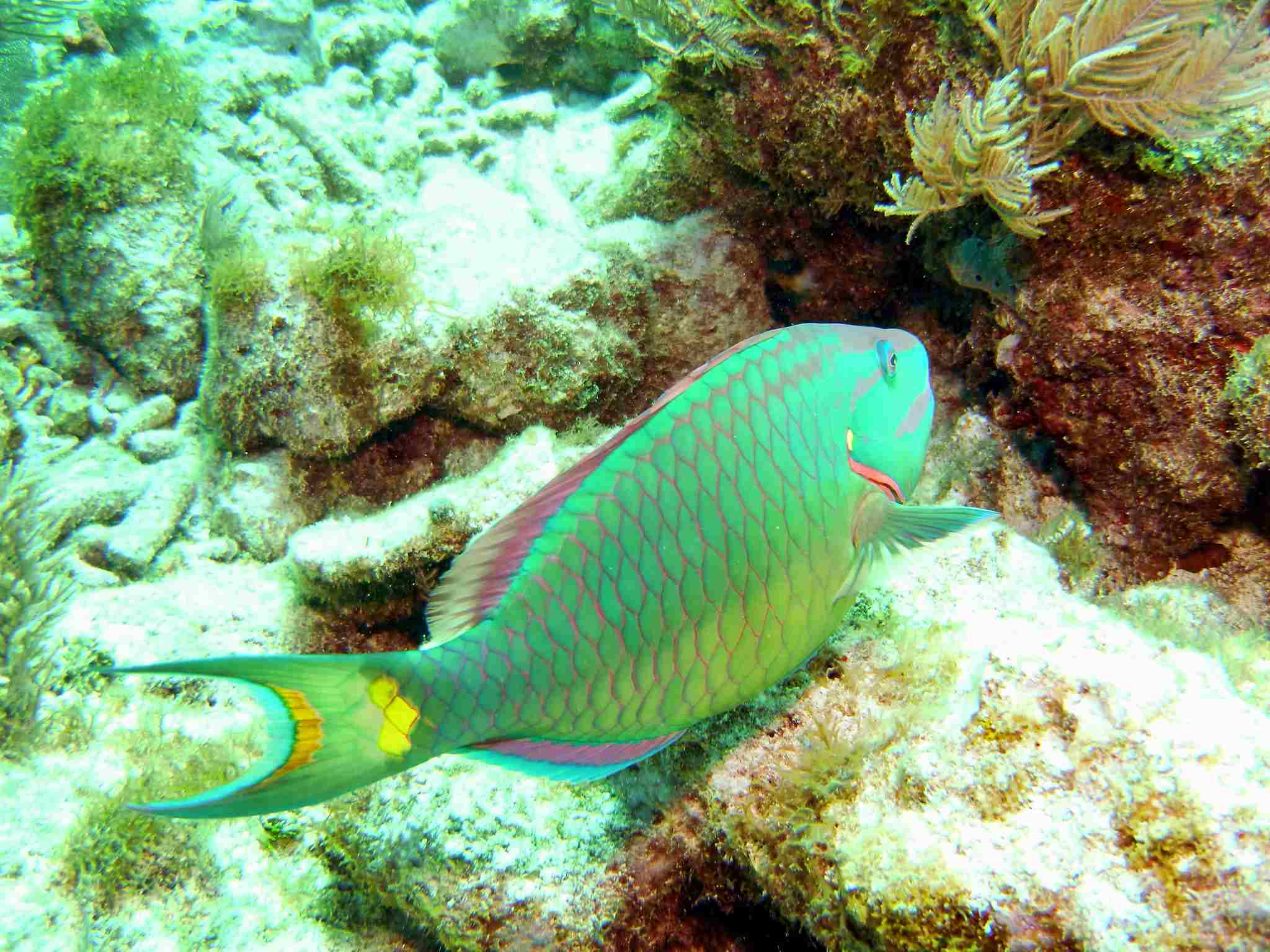
2. What are Parrotfish Prey?
Parrotfish are primarily herbivores and feed on producers such as algae and seagrass. However, they may occasionally consume other consumers as part of their diet. Parrotfish have been observed to eat zooplankton, sponges, and macroscopic crustaceans, although this is not their main source of food.
Their specialized beak-like teeth allow them to scrape algae and small organisms off corals and rocks, which form the bulk of their diet. This feeding behavior helps to control the growth of algae on coral reefs, promoting the health and growth of corals.
While parrotfish are not considered predatory, their occasional consumption of other consumers highlights their opportunistic feeding habits. However, it is important to note that these instances are rare and do not significantly impact the populations of the prey species.
3. Do Eels Eat Parrotfish?
Eels, especially moray eels, are known to eat parrotfish, particularly in reef zones. These predatory eels have a diverse diet that includes various marine organisms, and parrotfish are one of their prey.
Moray eels are well-adapted hunters with sharp teeth and a strong jaw, allowing them to capture and consume their prey efficiently. They often hide in crevices or coral reefs, waiting for an opportunity to ambush unsuspecting fish like parrotfish. When the moment is right, they strike with lightning speed, using their powerful jaws to grasp and swallow their prey whole.
While parrotfish are primarily herbivores, their occasional consumption by eels highlights the complex food web and predator-prey relationships in marine ecosystems. It is important to note that eels do not solely rely on parrotfish as their main food source, but they do play a role in the eel’s diet.
The interaction between eels and parrotfish is a natural part of the marine ecosystem, and it contributes to the balance and diversity of species within coral reefs. However, it is worth mentioning that the impact of eel predation on parrotfish populations is not significant enough to cause a decline in their numbers.
4. What Shark Eats Parrotfish?
Parrotfish are preyed upon by several species of sharks, particularly reef-dwelling sharks such as the blacktip reef shark, tiger shark, and grey reef shark. These sharks are known to include parrotfish in their diet, taking advantage of their abundance in coral reef ecosystems.
The blacktip reef shark, named for its distinctive black-tipped fins, is a common predator of parrotfish. With its agility and speed, it can easily catch parrotfish as they swim near the reef.
The tiger shark, known for its voracious appetite and broad diet, also preys on parrotfish. Its powerful jaws and sharp teeth enable it to capture and consume a variety of prey, including parrotfish.
Similarly, the grey reef shark, a reef-dwelling species, feeds on parrotfish as part of its diet. These sharks are skilled hunters, using their keen senses to locate and capture their prey.
5. Do Groupers Eat Parrot Fish?
Groupers are known to eat parrotfish, but they are not considered major predators. While groupers do consume parrotfish as part of their diet, they are not as specialized or dependent on parrotfish as some other predators. Groupers are large, predatory fish that inhabit coral reef ecosystems, and they have a diverse diet that includes a variety of prey. While they may opportunistically feed on parrotfish, they also consume other fish, crustaceans, and even smaller groupers. Groupers are known for their powerful jaws and ability to ambush their prey, making them formidable predators in their own right. However, when it comes to parrotfish, they are not as significant of a threat as sharks or other larger predators.
6. Do Parrotfish Eat Seagrass?
Yes, parrotfish do eat seagrass along with algae. Seagrass is an important part of the parrotfish diet, especially for certain species. Parrotfish are herbivores and have specialized teeth that allow them to scrape algae and seagrass off rocks and coral. They play a crucial role in maintaining the health of coral reefs by controlling the growth of algae, which can smother coral.
By consuming seagrass, parrotfish help to keep seagrass beds healthy and prevent overgrowth. However, it’s important to note that not all parrotfish species eat seagrass, and their diet can vary depending on their habitat and availability of food sources.
7. Do Moray Eels Eat Parrotfish?
Moray eels are known to be opportunistic predators, and yes, they do eat parrotfish. Moray eels have a diverse diet that includes fish, crustaceans, and even other eels. Parrotfish are not exempt from their menu. With their sharp teeth and powerful jaws, moray eels can easily capture and consume parrotfish.
Moray eels are ambush predators, hiding in crevices or coral reefs, waiting for their prey to swim by. When a parrotfish comes within striking distance, the moray eel lunges forward, clamping its jaws around the fish and swallowing it whole.
While moray eels may not be the primary predators of parrotfish, they are certainly capable of preying on them.
8. Do Sharks Eat Parrot Fish?
Sharks are known to eat parrotfish, especially reef sharks. These predators play a crucial role in maintaining the balance of the marine ecosystem. With their powerful jaws and sharp teeth, sharks are well-equipped to capture and consume parrotfish. When a parrotfish swims within the striking range of a shark, it quickly becomes a potential meal.
Sharks are opportunistic hunters and will take advantage of any opportunity to feed on parrotfish or other suitable prey. While sharks are not the only predators of parrotfish, their presence in the ocean serves as a reminder of the complex food web and the interconnectedness of marine life.
9. Do Parrotfish Eat Phytoplankton?
Parrotfish primarily feed on algae, including both sessile algae found on reefs and phytoplankton. While they do consume phytoplankton, it is not as common as their consumption of sessile algae. Phytoplankton are microscopic plants that drift in the water column, and parrotfish may occasionally ingest them while feeding on other food sources.
Parrotfish play a crucial role in maintaining the health of coral reefs by grazing on algae, preventing it from overgrowing and smothering the coral. Their feeding habits help to keep the ecosystem in balance and promote coral growth.
However, it is important to note that parrotfish primarily rely on algae as their main food source, and their consumption of phytoplankton is not as significant. Their feeding behavior is more focused on grazing on the algae that grow on reefs, which is essential for the overall health and survival of coral ecosystems.
10. Are Parrotfish Herbivores?
Parrotfish are indeed herbivores, as they primarily consume plant-based food sources. They play a crucial role in maintaining the balance of coral reef ecosystems by grazing on algae. Parrotfish feed on a variety of algae, including both sessile algae found on reefs and phytoplankton. While they do occasionally ingest phytoplankton, their main focus is on grazing on the algae that grow on reefs.
By feeding on algae, parrotfish prevent it from overgrowing and smothering the coral, which promotes coral growth and overall reef health. Their diet consists mainly of producers, such as algae, which makes them an essential part of the reef ecosystem.
11. Are Parrot Fish Poisonous to Eat?
Yes, there is a potential risk of ciguatera fish poisoning from consuming parrotfish. Ciguatera fish poisoning is caused by the accumulation of toxins produced by certain types of algae that the parrotfish may consume. These toxins can then be transferred to humans through the consumption of contaminated fish. Symptoms of ciguatera poisoning can include gastrointestinal issues, neurological symptoms, and even long-term complications.
It is important to note that not all parrotfish carry ciguatera toxins, and the risk varies depending on the specific species and the location where the fish was caught. To ensure safety, it is recommended to only consume parrotfish from reputable sources and to be aware of any local advisories or warnings regarding ciguatera poisoning.
